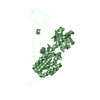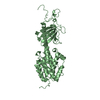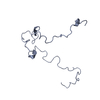+Search query
-Structure paper
| Title | The Two-State Prehensile Tail of the Antibacterial Toxin Colicin N. |
|---|---|
| Journal, issue, pages | Biophys J, Vol. 113, Issue 8, Page 1673-1684, Year 2017 |
| Publish date | Oct 17, 2017 |
 Authors Authors | Christopher L Johnson / Alexandra S Solovyova / Olli Hecht / Colin Macdonald / Helen Waller / J Günter Grossmann / Geoffrey R Moore / Jeremy H Lakey /  |
| PubMed Abstract | Intrinsically disordered regions within proteins are critical elements in many biomolecular interactions and signaling pathways. Antibacterial toxins of the colicin family, which could provide new ...Intrinsically disordered regions within proteins are critical elements in many biomolecular interactions and signaling pathways. Antibacterial toxins of the colicin family, which could provide new antibiotic functions against resistant bacteria, contain disordered N-terminal translocation domains (T-domains) that are essential for receptor binding and the penetration of the Escherichia coli outer membrane. Here we investigate the conformational behavior of the T-domain of colicin N (ColN-T) to understand why such domains are widespread in toxins that target Gram-negative bacteria. Like some other intrinsically disordered proteins in the solution state of the protein, ColN-T shows dual recognition, initially interacting with other domains of the same colicin N molecule and later, during cell killing, binding to two different receptors, OmpF and TolA, in the target bacterium. ColN-T is invisible in the high-resolution x-ray model and yet accounts for 90 of the toxin's 387 amino acid residues. To reveal its solution structure that underlies such a dynamic and complex system, we carried out mutagenic, biochemical, hydrodynamic and structural studies using analytical ultracentrifugation, NMR, and small-angle x-ray scattering on full-length ColN and its fragments. The structure was accurately modeled from small-angle x-ray scattering data by treating ColN as a flexible system, namely by the ensemble optimization method, which enables a distribution of conformations to be included in the final model. The results reveal, to our knowledge, for the first time the dynamic structure of a colicin T-domain. ColN-T is in dynamic equilibrium between a compact form, showing specific self-recognition and resistance to proteolysis, and an extended form, which most likely allows for effective receptor binding. |
 External links External links |  Biophys J / Biophys J /  PubMed:29045862 / PubMed:29045862 /  PubMed Central PubMed Central |
| Methods | SAS (X-ray synchrotron) |
| Structure data |  SASDC23:  SASDC33:  SASDC43:  SASDC53: |
| Source |
|
 Movie
Movie Controller
Controller Structure viewers
Structure viewers About Yorodumi Papers
About Yorodumi Papers




 Escherichia coli (E. coli)
Escherichia coli (E. coli)